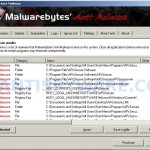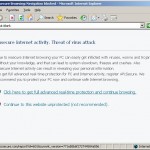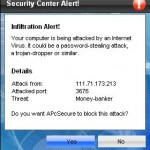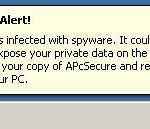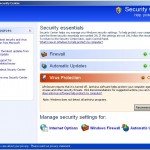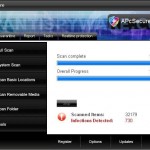 APcSecure is a rogue antispyware program. It is installed throught the use of trojans that come from fake “youtube” websites that ask users to download a fake codec or a flash player update needed to view a video online. Once the trojan is started, it will download and install APcSecure onto your computer and register it in the Windows registry by creating a registry value at the “HKEY_LOCAL_MACHINE\SOFTWARE\Microsoft\Windows\CurrentVersion\Run” to run automatically when Windows starts. The trojan will also create numerous files with random names that made to appear as infections, but in reality all of them are harmless.
APcSecure is a rogue antispyware program. It is installed throught the use of trojans that come from fake “youtube” websites that ask users to download a fake codec or a flash player update needed to view a video online. Once the trojan is started, it will download and install APcSecure onto your computer and register it in the Windows registry by creating a registry value at the “HKEY_LOCAL_MACHINE\SOFTWARE\Microsoft\Windows\CurrentVersion\Run” to run automatically when Windows starts. The trojan will also create numerous files with random names that made to appear as infections, but in reality all of them are harmless.
When APcSecure is running, it will imitate a system scan and labels previously created files as spyware, malware and worms to make you think that your computer in danger! Then it will prompt you to pay for a full version of the rogue program to remove them. This is of course nothing more but a scam. So, you can safety ignore the scan results!
What is more, the trojan that installs APcSecure will also download and install two another trojans. First trojan is a variant of trojan FakeAlert that will display a lot of fake spyware alerts and a fake Windows Security Center that will suggest you register the rogue. Some of the alerts:
Spyware Alert!
Your computer is infected with spyware. It could damage your
critical files or expose your private data on the Internet. Click
here to register your copy of APcSecure and remove
spyware threats from your PC.
Security Center Alert!
Infiltration alert!
Your computer being attacked by an Internet
Virus. It could be a password-stealing attack,
a trojan-dropper or simular.
Do you want APcSecure to block this attack?
Of course, like false scan results, all of these alerts and suggestions are fake and should be ignored! Second trojan is a variant of trojan/rootkit TDSS. The trojan may redirect search results in Google, Yahoo, MSN, block an access to security websites and much more.
If you find that your computer is infected with this malware, then be quick and take effort to remove it immediately. Use the removal guide below to remove APcSecure from your computer for free.
More screen shoots of THREATNAME
Symptoms in a HijackThis Log
O4 – HKLM\..\Run: [APcSecure] C:\Program Files\APcSecure Software\APcSecure\APcSecure.exe -min
O4 – HKCU\..\Run: [
Spyware software are surreptitiously installed on user`s computer to collect information about computer’s configuration, user`s private information, user’s activity without his consent. Spyware may also change Windows settings, download and install other malicious programs without the user’s knowledge.
.exe] C:\WINDOWS\system32\Spyware software are surreptitiously installed on user`s computer to collect information about computer’s configuration, user`s private information, user’s activity without his consent. Spyware may also change Windows settings, download and install other malicious programs without the user’s knowledge.
.exeUse the following instructions to remove APcSecure (Uninstall instructions)
Download TDSSKiller from here and unzip to your desktop.
Open TDSSKiller folder and double click the TDSSKiller icon. Follow the prompts.
Download MalwareBytes Anti-malware (MBAM). Close all programs and Windows on your computer.
Double Click mbam-setup.exe to install the application. When the installation begins, keep following the prompts in order to continue with the installation process. Do not make any changes to default settings and when the program has finished installing, make sure a checkmark is placed next to Update Malwarebytes’ Anti-Malware and Launch Malwarebytes’ Anti-Malware, then click Finish.
If an update is found, it will download and install the latest version.
Once the program has loaded you will see window similar to the one below.
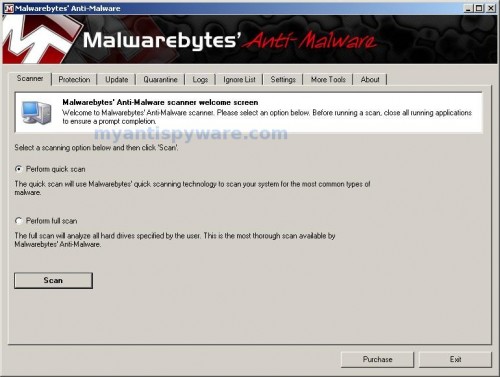
Malwarebytes Anti-Malware Window
Select Perform Quick Scan, then click Scan, it will start scanning your computer for APcSecure infection. This procedure can take some time, so please be patient.
When the scan is complete, click OK, then Show Results to view the results. You will see a list of infected items similar as shown below. Note: list of infected items may be different than what is shown in the image below.
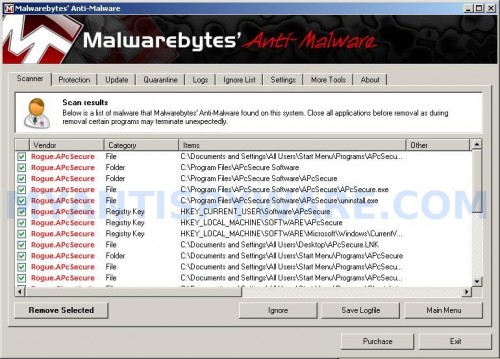
Malwarebytes Anti-malware, list of infected items
Make sure that everything is checked, and click Remove Selected for start APcSecure removal process. When disinfection is completed, a log will open in Notepad and you may be prompted to Restart.
Note: if you need help with the instructions, then post your questions in our Spyware Removal forum.
APcSecure creates the following files and folders
C:\Program Files\APcSecure Software
C:\Program Files\APcSecure Software\APcSecure
C:\Documents and Settings\All Users\Start Menu\Programs\APcSecure
C:\Documents and Settings\All Users\Start Menu\Programs\APcSecure\3 Uninstall.lnk
C:\Program Files\APcSecure Software\APcSecure\APcSecure.exe
C:\Program Files\APcSecure Software\APcSecure\uninstall.exe
C:\Documents and Settings\All Users\Desktop\APcSecure.LNK
C:\Documents and Settings\All Users\Start Menu\Programs\APcSecure\1 APcSecure.lnk
C:\Documents and Settings\All Users\Start Menu\Programs\APcSecure\2 Homepage.lnk
C:\WINDOWS\system32\
C:\WINDOWS\system32\spool\prtprocs\w32x86\00001891.tmp
C:\WINDOWS\system32\spool\prtprocs\w32x86\00003e17.tmp
APcSecure creates the following registry keys and values
HKEY_CURRENT_USER\Software\APcSecure
HKEY_LOCAL_MACHINE\SOFTWARE\APcSecure
HKEY_LOCAL_MACHINE\SOFTWARE\Microsoft\Windows\CurrentVersion\Uninstall\APcSecure
HKEY_CURRENT_USER\SOFTWARE\Microsoft\Windows\CurrentVersion\Run\
Spyware software are surreptitiously installed on user`s computer to collect information about computer’s configuration, user`s private information, user’s activity without his consent. Spyware may also change Windows settings, download and install other malicious programs without the user’s knowledge.
.exeHKEY_LOCAL_MACHINE\SOFTWARE\Microsoft\Windows\CurrentVersion\Run\APcSecure

